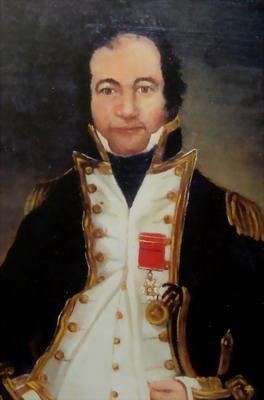Name Richard Spencer | Died July 24, 1839 | |
 | ||
Captain Sir Richard Spencer KCH (9 December 1779 – 24 July 1839) the son of Richard Spencer, a London merchant. He was a sea captain of the Royal Navy who served in a number of battles, particularly against the French. Later in life he settled in Albany, Western Australia and was appointed Government Resident in 1833. He was born in Southwark, in London's dockland, and died at Strawberry Hill Government Farm, Mira Mar in Albany, Western Australia.
Contents
Naval career
He joined the ship's complement of the 38-gun frigate HMS Arethusa, in 1793, as captain's servant. He joined the 74-gun HMS Leviathan in 1794. He took part in the 3rd Battle of Ushant, also known as the Glorious First of June, in 1794. He transferred to the HMS Sans Pareil after she was captured in the battle. He was wounded in action on 23 June.
Spencer was appointed a midshipman in 1795 and moved to HMS Hornet, a 16-gun sloop, under Robert Larkan. He went with Larkan to the latter's new command, the 20-gun HMS Camilla, in September 1797.
In 1799, Spencer was promoted to the rank of lieutenant. He was commissioned into HMS Queen Charlotte (1790), a 100-gun ship of the line. However, she blew up in an accident before he could join her. He joined the 80-gun Guillaume Tell, one of the few French ships to escape Nelson at the Battle of the Nile. She had, however, subsequently been captured. She was then renamed HMS Malta. He then joined the sloop HMS Cameleon, as lieutenant to the captain. This vessel supported the campaign to oust Napoleon's troops from Egypt.
Spencer was captured in Genoa in 1803, having been put ashore after hostilities had again broken out after the Treaty of Amiens. He escaped in the Danish vessel Enighiden and was rescued by HMS Phoebe. From here, he was transferred to HMS Victory, Nelson's flagship in the Mediterranean. He gave Nelson what information he had gleaned from his stay in Genoa.
Nelson appointed him to command the captured French 12-gun privateer schooner Renard; her name was changed to HMS Crafty. He was injured by an oar on board the Crafty's jolly boat, which may have left a permanent mark on his health. He did not take part in the Battle of Trafalgar but he had lost a useful friend in Nelson. In 1806, he captured vessels running sulphur from Sicily to Toulon, France, for making gunpowder. He took part in the Battle of Maida, in which his vessel harassed the retreating French army. By successful diplomacy, he obtained the release of Christian slaves from the Dey of Algiers. He personally saved his ship from accidental destruction by the much larger HMS Eagle, in Valletta harbour. He had to surrender his ship to three Spanish privateers, in 1807. He was later cleared by court martial for the loss of Crafty, but was reprimanded for having lost contact with HMS Confounder, with which he had been in company, and for staying too long at anchor in the harbour where the Spanish found him.
He next was involved in action against the Dutch, in the East Indies. He was promoted to Commander on 8 April 1808 and given command of Samarang, in which he participated in the capture of Amboyna and captured Pulo Ay. He was made post captain on 25 July 1810 and then on 18 August took command of HMS Blanche. Prize money acquired during his successful career, enabled him and his family to settle down, after the end of hostilities, in 1815. He retired from the Navy during 1817
Marriage
While in the evening of his Royal Navy career, he married Ann Warden Liddon, of Charmouth, near Lyme Regis in Dorset, England. Their first son, Richard, was born in Charmouth in 1814 but died in Malta in 1815. They were to have 10 children.
Lyme Regis
He bought a house in Lyme Regis, in 1817. This was situated on the Exeter road, overlooking the Cobb harbour. After the Great Storm of 1824, no doubt stimulated by fears for the safety of shipping on that treacherous coast, he was engaged in pioneering ideas for a buoyant and self-righting 'lifeboat'. This was an adapted pilot boat, with copper buoyancy tanks fitted.
Knighthood and Australia
Richard Spencer followed news of the colonisation of Australia with interest. He determined to emigrate for the sake of the future of his several children. He was knighted in 1833 (Companion of the Bath 1815 and Knight of the Royal Hanoverian Guelphic Order 1833). He became a Military Knight Commander of the Royal Hanoverian Guelphic Order. This was not a government nomination but was in the personal gift of King William IV. He was appointed Government Resident of the settlement of Albany, Australia, in 1833. Spencer, together with 21 members of his family and servants, emigrated to Australia arriving in Albany September 1833 with merino sheep, cattle, horses other livestock along with plants, fruit-tree cuttings and seeds.
In his time in Australia, he pioneered farming methods suitable to that difficult terrain and climate. Spencer died at his residence on 24 July 1839. His two eldest sons died in two tragic accidents shortly after their father's death. Daughters Eliza Lucy married Sir George Grey and Augusta married George Edward Egerton-Warburton, a settler near Mount Barker.
